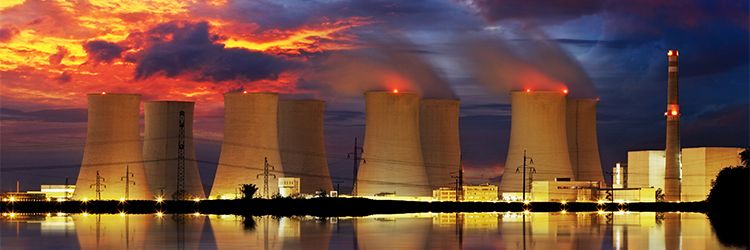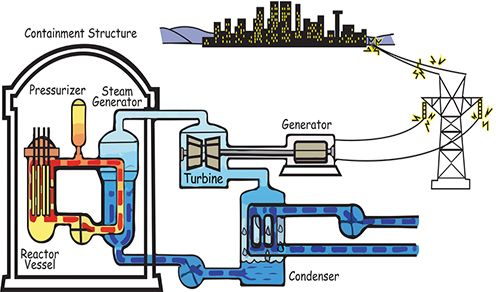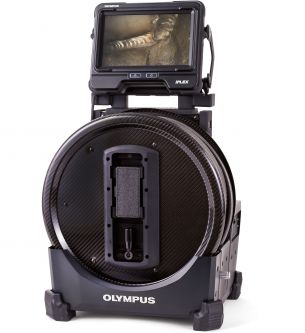For personnel in nuclear power plants, time and distance are critical measurements when it comes to
Suspected corrosion or blocked conduits or vessels in the containment area need to be handled immediately to help avoid accidental radiation leakage. In some cases, the reactor may need to be shut down so that workers outfitted in full-body protective gear can carry out the inspection. However, remote visual inspection (RVI) offers an alternative to this method, helping avoid costly shutdowns, saving time and operational costs, and reducing the risk of a harmful radiation dose for workers.
Radiation Exposure, Limits, and Risks
Exposure to radiation in the workplace is strictly regulated by safety standards, with the annual effective dose limit set at 5 rems (0.05 sieverts (Sv)). For comparison, the average person is exposed to less than 0.003 sieverts of naturally occurring radiation in a year. Workers in nuclear plants are generally exposed to less than 0.01 Sv annually. According to the standards, this level is considered reasonably safe.
As Low as Reasonably Achievable: How Low Can You Go?
Despite the general safety of working in a nuclear power plant, the as low as reasonably achievable (ALARA) principle dictates that workplace radiation safety programs should minimize employee exposure as much as possible. RVI methods can enable these workers to make their inspections from a sufficient distance to help decrease their annual effective dose level.
What RVI Can Do to Reduce Radiation Exposure
Water is essential to nuclear energy production and how the water is used can vary depending on the plant and type of technology, but generally, water is used in three stages.
Stage 1: In the radiation containment building, water helps cool the uranium rods in the nuclear reactor; during this process, the water is heated by the reactor.
Stage 2: The radioactive (or “dirty”) water from the reactor is sent in a loop to heat a reservoir of fresh, clean water.
Stage 3: Once the clean water is heated, it turns into steam, which powers the generator’s turbine.
The pipes and vessels located within the containment structure are in a high-radiation area. Even with
RVI offers a way for workers to carry out inspections in hazardous locations without physically entering the area. As well as letting workers maintain a safe distance from high-radiation areas, a videoscope equipped with a long insertion tube can enable the inspection of difficult-to-access locations, such as water conduits. The longer the insertion tube, the farther away the workers can be from the radiation.
Videoscope Durability in Radioactive Conditions
Unfortunately, even the best videoscope equipment doesn’t come out completely unscathed when exposed to radiation. If the insertion tube is used to inspect dirty-water-filled pipes, contamination is inevitable, and damage is also a possibility.
For example, with long-term exposure, the clear fiberoptic material used in insertion tubes for illumination can begin to turn yellow. This yellowing causes it to absorb light, reducing the intensity at the tip. The tube’s image sensor is more susceptible to damage from short, high doses of radiation, which can result in a noisy, or milky, image on the videoscope screen.
When the equipment is used in high-radiation areas, in some instances, decontaminating the equipment may be considered too costly and risky for the health of the workers. The plant may opt to sacrifice the insertion tube, leaving it permanently in the radiation area. Regardless, the insertion tube and the videoscope need to be robust enough to satisfy the requirements and expectations of the nuclear plant’s safety inspection and maintenance programs. That’s why we build systems with features that enable them to survive longer in radiation areas.
5 Advantages of the IPLEX™ GAir Videoscope in Nuclear Power Plants
Resistant to radiation damage
We tested the IPLEX GAir videoscope’s insertion tube and found that, even after being exposed to 1,400 Gy (a unit that measures an absorbed radiation dose) cumulatively, the laser illumination and CCD image sensor still work. Particularly beneficial is the videoscope's LED illuminated optical tip adaptor, which eliminates the necessity of using optical fibers that can yellow when exposed to radition. This results in a longer lifetime in a radioactive environment. Depending on the type of radiation, 1 Gy is roughly equal to 1 sievert. So, that means that the insertion tube can withstand many times more radiation than the established safe limits for workers: around 140,000 times a person's annual exposure limit.
Inspect from a safer distance
The IPLEX GAir videoscope has an extra-long insertion tube that enables workers to make inspections from a safer distance. The 30-meter (100-foot) tube can be fed into dirty water pipes in the radiation containment area, and workers can control and maneuver it from afar. For greater flexibility, a USB wireless LAN adaptor enables you to observe live images and record still images and movies on a tablet PC from 15 m to 20 m (49 ft to 65 ft) away from the unit. With a commercially available repeater system, the IPLEX GAir videoscope can be remotely controlled from up to 100 m (328 ft) away.
Replaceable insertion tube
The IPLEX GAir videoscope's interchangeable insertion tube can be replaced at the inspection site. This saves time and reduces cost since the inspector can bring a spare scope and change it in the field if the original becomes contaminated with radiation.
See the light
Image brightness is essential to inspect the inside of a pipe or vessel from far away. The IPLEX GAir videoscope's optical tip adaptor with LED illumination continuously delivers bright light regardless of the scope length. Combined with WiDER™ (wide, dynamic extended range) image processing, the videoscope delivers bright, contrast-balanced images across the entire depth of field. In addition, the long exposure function help users find defects easily when inspecting large spaces, such as a reactor vessel.
Easy handling for quick inspection
To maximize an inspector's safety, inspections in a radiation environment must be completed as quickly as possible.
The IPLEX GAir videoscope's pneumatic articulation is compact with an integrated air compressor, enabling you to quickly carry the system to an inspection site. When maneuvering through a pipe, a gravity sensor in the scope tip automatically orients the image so that you know which direction is up, reducing any confusion and speeding up the inspection. In addition, a guide head on the scope's distal end makes inserting the scope smooth when passing through a pipe elbow to further enhance speed.
Related Content
What
Videoscope Inspection at Hydraulic Power Plants
Maintaining Uptime in Turbine Inspections Using the IPLEX NX Videoscope
Get In Touch



